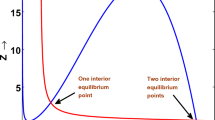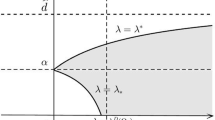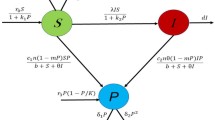Abstract
In this paper, we analyze the features of a stochastically perturbed two-species predator-prey patch-system with ratio-dependent functional response. We first prove that the system which we investigate has a unique global positive solution. Then, the sufficient criteria for the existence and uniqueness of an ergodic stationary distribution of positive solutions to the system are presented by establishing a series of suitable Lyapunov functions.
Similar content being viewed by others
Availability of Data and Material
All data are fully available without restriction.
References
Arditi, R., Salah, H.: Empirical evidence of the role of heterogeneity in ratio-dependent consumption. Ecology 73, 1544–1551 (1992)
Arditi, R., Ginzburg, L.R., Akcakaya, H.R.: Variation in plankton densities among lakes: a case for ratio-dependent models. Am. Nat. 138, 1287–1296 (1991)
Arditi, R., Perrin, N., Saiah, H.: Functional response and heterogeneities: an experiment test with clado-cerans. OIKOS 60, 69–75 (1991)
Gutierrez, A.P.: The physiological basis of ratio-dependent predator-prey theory: a methbolic pool model of Nicholson’s blowflies as an example. Ecology 73, 1552–1563 (1992)
Li, Z., Chen, L., Huang, J.: Permanence and periodicity of a delayed ratio-dependent predator-prey model with Holling type functional response and stage structure. J. Comput. Appl. Math. 233, 173–187 (2009)
Hanski, I.: The functional response of predator: worries bout scale. TREE 6, 141–142 (1991)
Dolman, P.M.: The intensity of interference varies with resource density: evidence from a field study with snow buntings, Plectrophenax nivalis. Oecologia 102, 511–514 (1995)
Jost, C., Arditi, R.: From pattern to process: identifying predator-prey models from time-series data. Popul. Ecol. 43, 229–243 (2001)
Skalski, G.T., Gilliam, J.F.: Functional responses with predator interference: viable alternatives to the Holling type II model. Ecology 82, 3083–3092 (2001)
Gao, X., Ishag, S., Fu, S., Li, W., Wang, W.: Bifurcation and Turing pattern formation in a diffusive ratio-dependent predator-prey model with predator harvesting. Nonlinear Anal. Real World Appl. 51, 102962 (2020)
Zhang, X., Liu, Z.: Periodic oscillations in age-structured ratio-dependent predator-prey model with Michaelis-Menten type functional response. Phys. D 389, 51–63 (2019)
Arditi, R., Ginzburg, L.R.: Coupling in predator-prey dynamics: ratio-dependence. J. Theor. Biol. 139, 311–326 (1989)
Jorné, J., Safriel, U.N.: Linear and non-linear diffusion models applied to the behavior of a population of an intertidal snail. J. Theor. Biol. 79, 367–380 (1979)
Liu, M., Deng, M., Du, B.: Analysis of a stochastic logistic model with diffusion. Appl. Math. Comput. 228, 141–146 (2014)
Gramlich, P., Plitzko, S.J., Rudolf, L., Drossel, B., Gross, T.: The influence of dispersal on a predator-prey system with two habitats. J. Theor. Biol. 398, 150–161 (2016)
Kang, Y., Kumar Sasmal, S., Messan, K.: A two-patch prey-predator model with predator dispersal driven by the predation strength. Math. Biosci. Eng. 14, 843–880 (2017)
Xu, R., Chen, L.: Persistence and stability for a two-species ratio-dependent predator-prey system with time delay in a two-patch environment. Comput. Math. Appl. 40, 577–588 (2000)
Kumar, A.: Rajeev: a moving boundary problem with space-fractional diffusion logistic population model and density-dependent dispersal rate. Appl. Math. Model. 88, 951–965 (2020)
Freedman, H.I., Takeuchi, Y.: Predator survial versus extinction as a function of dispersal in a predator-prey model with pacthy environment. Nonlinear Anal. 13, 993–1002 (1989)
Huang, R., Wang, Y., Wu, H.: Population abundance in predator-prey systems with predator’s dispersal between two patches. Theor. Popul. Biol. 135, 1–8 (2020)
Cui, J., Takeuchi, Y., Lin, Z.: Permanence and extinction for dispersal population systems. J. Math. Anal. Appl. 298, 73–93 (2004)
Sasmal, S.K., Ghosh, D.: Effect of dispersal in two-patch prey-predator system with positive density dependence growth of preys. BioSystems 151, 8–20 (2017)
Zhang, S., Zhang, T., Yuan, S.: Dynamics of a stochastic predator-prey model with habitat complexity and prey aggregation. Ecol. Complex. 45, 100889 (2021)
May, R.M.: Stability and Complexity in Model Ecosystems. Princeton University Press, NJ (2001)
Pimentel, C.E.H., Rodriguez, P.M., Valencia, L.A.: A note on a stage-specific predator-prey stochastic model. Phys. A 553, 124575 (2020)
Feng, T., Meng, X., Zhang, T., et al.: Analysis of the predator-prey interactions: a stochastic model incorporating disease invasion. Qual. Theory Dyn. Syst. 19, 55 (2020)
Wang, Z., Deng, M., Liu, M.: Stationary distribution of a stochastic ratio-dependent predator-prey system with regime-switching. Chaos Solitons Fractals 142, 110462 (2021)
Zou, X., Lv, J., Wu, Y.: A note on a stochastic Holling-II predator-prey model with a prey refuge. J. Frankl. Inst. Eng. Appl. Math. 357, 4486–4502 (2020)
Liu, C., Wang, L., He, D., Li, M.: Stochastic dynamical analysis in a hybrid bioeconomic system with telephone noise and distributed delay. J. Frankl. Inst. Eng. Appl. Math. 357, 4922–4948 (2020)
Roy, J., Barman, D., Alam, S.: Role of fear in a predator-prey system with ratio-dependent functional response in deterministic and stochastic environment. BioSystems 197, 104176 (2020)
Ren, Y., Sakthivel, R.: Stochastic differential equations with perturbations driven by G-Brownian motion. Qual. Theory Dyn. Syst. 19, 74 (2020)
Liu, Q., Jiang, D., Hayat, T., Ahmad, B.: Stationary distribution and extinction of a stochastic predator-prey model with additional food and nonlinear perturbation. Appl. Math. Comput. 320, 226–239 (2018)
Mao, X.: Stochastic Differential Equations and Applications. Horwood Publishing, Chichester (1997)
Zhao, X., Zeng, Z.: Stationary distribution and extinction of a stochastic ratio-dependent predator-prey system with stage structure for the predator. Phys. A 545, 123310 (2020)
Qi, H., Leng, X., Meng, X., et al.: Periodic solution and ergodic stationary distribution of SEIS dynamical systems with active and latent patients. Qual. Theory Dyn. Syst. 18, 347–369 (2019)
Liu, Y., Xu, H., Li, W.: Intermittent control to stationary distribution and exponential stability for hybrid multi-stochastic-weight coupled networks based on aperiodicity. J. Frankl. Inst. Eng. Appl. Math. 356, 7263–7289 (2019)
Higham, D.J.: An algorithmic introduction to numerical simulation of stochastic differential equations. SIAM Rev. 43, 525–546 (2001)
Khasminskii, R.: Stochastic Stability of Differential Equations. Springer, Heidelberg Dordrecht London, New York (2012)
Author information
Authors and Affiliations
Corresponding author
Additional information
Publisher's Note
Springer Nature remains neutral with regard to jurisdictional claims in published maps and institutional affiliations.
Rights and permissions
About this article
Cite this article
Zhao, X., Zeng, Z. Stochastic Dynamics of a Two-Species Patch-System With Ratio-Dependent Functional Response. Qual. Theory Dyn. Syst. 21, 58 (2022). https://doi.org/10.1007/s12346-022-00594-x
Received:
Accepted:
Published:
DOI: https://doi.org/10.1007/s12346-022-00594-x




